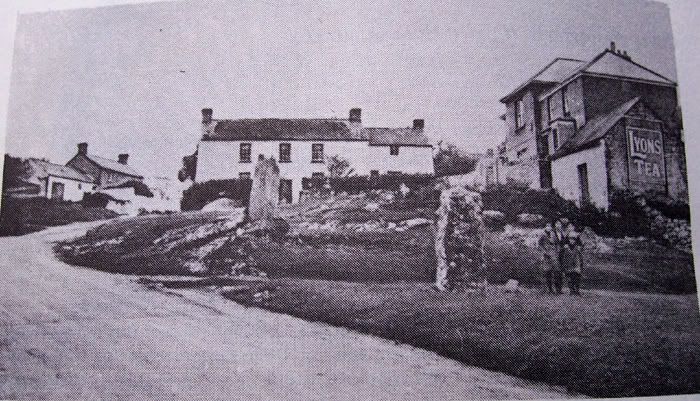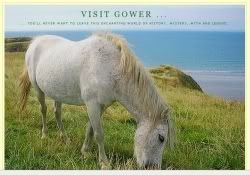
Today's Heads or Tails Tuesday theme is Road. Wherever possible, I try to give my memes a local flavour, and today is no different.
I live near the scenic Gower Peninsula, and I'd like to tell you a little bit about the history of Gower's roads. The area's main roads were not tarred over until after World War I, so until then, most of its roads were little more than dirt tracks. A few were surfaced with a loose layer of crushed limestone. The roads could be treacherous. So, even well into the early 1900s, Gower folk rarely ventured away from home. Archival sources from the eighteenth and nineteenth centuries, depicted the trepidation with which Gowerians viewed 'foreign' travel. If a Gower farmer was due to travel to London, or some other distant place, no-one really expected him to make it back alive. So he would make his will and hold a final farewell supper for family and friends. When he returned, a similar celebratory feast was held, to hail his safe return.
Gower roads were so treacherous, wheeled carts were not in general use until after 1830. This fact is quite staggering, when you place it in perspective. The first crude, wheeled vehicle was invented around 8,000 B.C. in Asia. The oldest surviving wheel was discovered in Mesopotamia, and is believed to hail from around 3,500 B.C. These crude wheels were improved upon by the Egyptians, around 2,000 BC, and later, the Greeks. The advent of more modern-looking two and four-wheeled vehicles is attributed to the Romans. Yet in 1830, Gower farmers still relied on their packhorses, and transported their wares on primitives sleds or slide-cars. Wheeled vehicles were considered too costly and troublesome, as the rough roads would soon break an axle or wheel, and isolated Gower had no wheelwrights who could repair such vehicles.
The nineteenth century Gower road map bore little resemblance to the Ordinance Survey map of today. Instead of main arteries, there was an extensive network of lanes and tracks. This network linked every village and farm, and many of these roads, although overgrown, still remain, often serving as public footpaths.
A new road was constructed in the 1920's, between the coastal villages of Penclawdd and Llanrhidian. It replaced a winding, narrow, flood-prone road through the salt marshes. Prior to the First World War, life moved at a slower pace. Locals saw no great hardship in waiting for the high tide to subside, before continuing their journey through the marsh. Those who chose not to wait, would drive their horse-drawn carts on through chest-high water, their carts often half-afloat. To ensure such reckless locals did not perish in the deep gullies and ditches beside the submerged road, the local council installed stout wooden posts, which were visible above water level. The remains of these posts can still be seen today.
As mentioned earlier, many of Gower's roads were covered with crushed limestone. This made travel a very messy affair, thanks to the clouds of white dust hurled up by the passage of hooves and wheels. The exception to this was the unsurfaced road traversing the red sandstone ridge of Cefn Bryn. A journey over the Bryn would throw up clouds of red dust, and the road was known locally as the Red Road. On the limestone roads, when two or more vehicles went by in quick succession, other road users could not make out the road ahead, due to the massive white dust cloud thrown up. The photograph below it shows an old, limed road.
Gower's roads must have been so tranquil in those days. Nowadays, the roads are still narrow and winding. But the sheer volume of traffic can be quite staggering, especially during the tourist season. You can imagine the chaos when the tourist coaches, caravans and other large vehicles hit the road. Throw in all the cars driven by locals, day-trippers and tourists, and it gets quite hairy. Also, it's not unusual to see mobile homes and caravans being transported on huge lorries, through tiny lanes, with police escorts. And as it's an agricultural area, you'll often find slow-moving farm tractors on the road, as well as farmers driving sheep and cattle along. Gower also has large tracts of unfenced, common land, so it's not unusual to find sheep, cattle and wild ponies wandering in the road.
Anyway, that's my road story for this week's Heads or Tails. Visit Barb/Skittles for some more Heads or Tails.





6 comments:
I would absolutely love to be there to see the sheep, cattle, and ponies in the road and being herded down the road. Can't help myself, I'm an animal gal through and through.
I love these mini-vacations you take us on. Like misty dawn said.. I too would love to visit. But not in tourist season. :)
This was a very interesting and insightful post. A nice lesson in history. It's a good thing with the way things are today that the roads are much better as many travel many miles just to get to work now. Good post.
Mother used to visit a farm on Clyne before the First War where the girls in the family had never been to Swansea which was about an hour and a half walk away at most.
Yet the cockle women of Penclawdd would cover three times that distance with loaded baskets at least once a week.
I am going to put a pic on Mono that illustrates your point about sheep.
But you aint seen tractors until you come to Ireland.
A.
That's a fascinating account. I loved reading it. I'm surprised anybody went anywhere at all (a prayer service and will! geez). You did a great job.
Thank you for sharing the interesting and colorful background of Gower Peninsula. Seems like a great place worth visiting someday.
Post a Comment